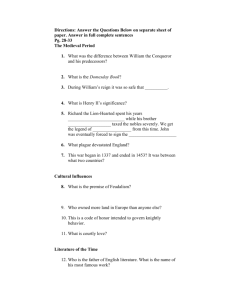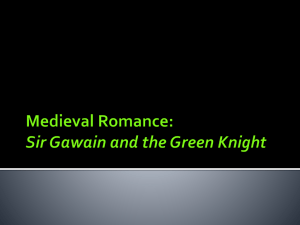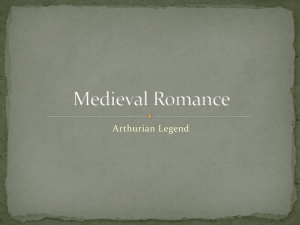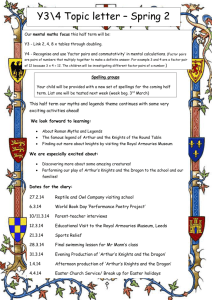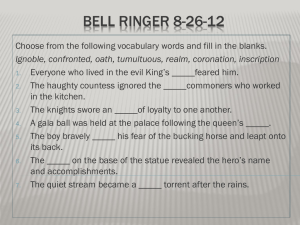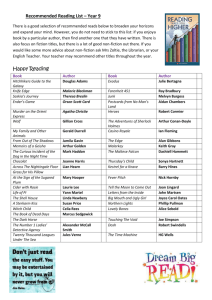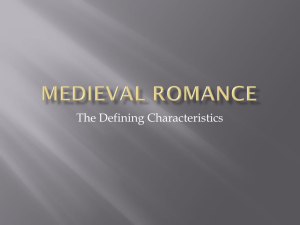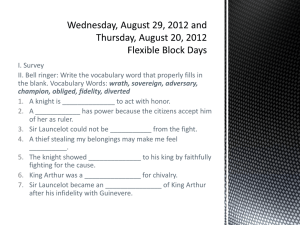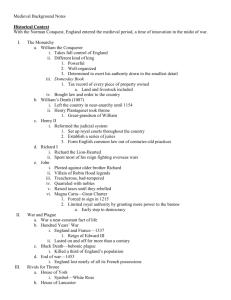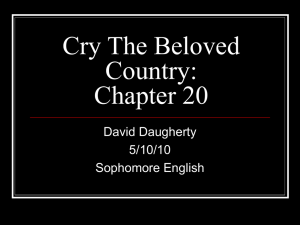the feudal system - Lake County Schools
advertisement
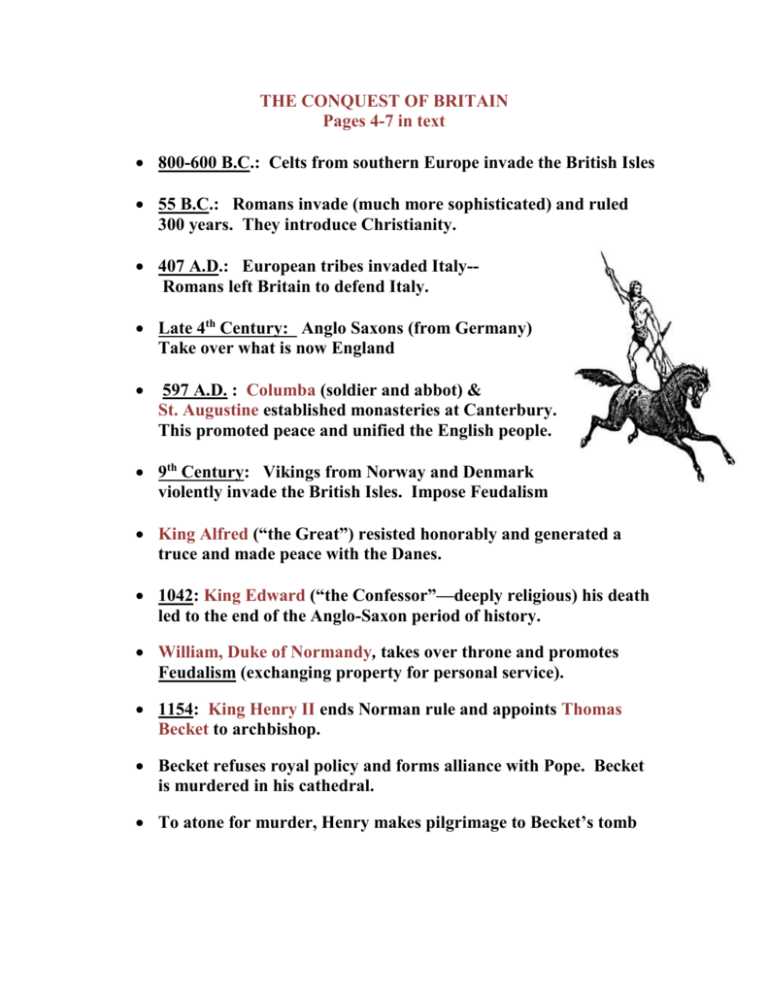
THE CONQUEST OF BRITAIN Pages 4-7 in text 800-600 B.C.: Celts from southern Europe invade the British Isles 55 B.C.: Romans invade (much more sophisticated) and ruled 300 years. They introduce Christianity. 407 A.D.: European tribes invaded Italy-Romans left Britain to defend Italy. Late 4th Century: Anglo Saxons (from Germany) Take over what is now England 597 A.D. : Columba (soldier and abbot) & St. Augustine established monasteries at Canterbury. This promoted peace and unified the English people. 9th Century: Vikings from Norway and Denmark violently invade the British Isles. Impose Feudalism King Alfred (“the Great”) resisted honorably and generated a truce and made peace with the Danes. 1042: King Edward (“the Confessor”—deeply religious) his death led to the end of the Anglo-Saxon period of history. William, Duke of Normandy, takes over throne and promotes Feudalism (exchanging property for personal service). 1154: King Henry II ends Norman rule and appoints Thomas Becket to archbishop. Becket refuses royal policy and forms alliance with Pope. Becket is murdered in his cathedral. To atone for murder, Henry makes pilgrimage to Becket’s tomb THE FEUDAL SYSTEM the land belonged to the king who divided it among his powerful supporters (the nobles). Nobles were given titles (Barons) Barons paid taxes and supplied knights to the king. Knights received smaller pieces of land (Manors) Peasants (serfs) worked the manors and were lowest class in the feudal system. THE FEUDAL SYSTEM’S DECLINE The Black Death (plague) in 1348 created labor shortages and increased value of peasant’s work. Landowners began paying more for work Free peasantry replaced the serfs. King Lords Lesser Lords Knights Peasants/ Townspeople Question: What aspects of feudal society are similar to aspects of modern-day America? Literature of the Period Began with spoken word—official records were not kept. Most were made up of the following: Heroic Poetry: The Epic: celebrating victories of war long narrative poem celebrating deeds of a warrior as in Beowulf The Elegy: a lyric poem mourning the loss of someone or something THE EXTETER BOOK A collection of manuscripts and stories told by scops (travelling storytellers) and compiled by monks during the reign of Alfred the Great (871-899) “The Seafarer” “The Wanderer” “The Wife’s Lament” All poems are lyric poetry—they express the thoughts and feelings of a single speaker. They are also about exile—a prolonged stay away from home that is forced. Journal Entry: Have you ever been exiled from someplace (home, school, a friend’s house, a job) or know of someone who has? If so, describe the event and how it made you feel. If not, discuss how it would make you feel if you were exiled from home. Beowulf (page 20) Britain’s first epic – long narrative poem celebrating the deeds of a hero It incorporates poetic devices Kenning: 2 word poetic renaming of a noun (example: “whale’s home” for the “sea”) Caesura: rhythmic breaks in the middle of lines—a pause for breath Beowulf is a self portrait of a culture (when Christianity began taking over pagan beliefs) About a warrior and slayer who aids a king in his fight of 3 battles against terrifying monsters. Beowulf: a warrior from southern Sweden (a Geat) King Hrothgar: Danish king who has been battling a monster for 12 years Grendel: Swampland creature terrorizing Hrothgar’s great banquet hall Beowulf is considered a true EPIC HERO --legendary hero— one who is larger than life whose accomplishments are celebrated in traditional tales. Questions to consider: 1. What are the similarities and differences between the first and last battle? 2. What qualities about Beowulf make him a legendary hero? 3. Cite some examples of boasting (bragging) from the characters Grendel, Beowulf, & Dragon. Discuss why they do this and whether or not it is effective. http://teacher2b.com/literature/beowlspl.htm History of the English Church and People (page 86) In the fifth century, Rome had abandoned Britain. To keep learning alive, monks kept knowledge flowing by copying books and preserving literature. Bede The most learned scholar of his day Wrote 40 books Helped originate the dating of events from the birth of Christ Main concern was the expansion of Christianity in England A History of the English Church and People Bede’s most famous piece of literature Describes the conquest of Britain by the Anglo-Saxon Tribes Translated from Latin to English for King Alfred The Anglo Saxon Chronicle A historic record of old kings and a soldier’s memories of battle Rewritten by monks to piece together historic events Became a kind of chain letter from one generation to another Chaucer and the Canterbury Tales Geoffrey Chaucer (1343?-1400) Page 100 Son of a merchant (middle class) Page in a royal house Served in the English army & captured in France Married Philippa Pan—a lady in waiting to the queen Began writing as a teen & evolved to be the Father of English Poetry Pilgrimage: a trip taken for inspiration The Canterbury Tales Through a window, Chaucer observed pilgrims starting their journey to Canterbury Tales about different characters and personal situations making the pilgrimage Only 24 of the 120 tales were finished The tales give a picture of various lifestyles and cultures of the time period Most tales are written in heroic couplet (pair of rhyming lines with 5 stressed syllables ) The Prologue: the narrator (Chaucer?) meets 29 pilgrims. Each must tell four tales during their journey. The person with the best tale is treated to a feast. Chaucer uses social commentary—writing that offers insight into society, its values and customs. He also uses direct and indirect characterization to describe each pilgrim. Direct Characterization: When the writer tells the reader specific details about the character’s personality and looks Example: The teacher was angry and frustrated with the class. Indirect Characterization: When the writer gives you details about the actions and words of the character and you the reader draw your own conclusions about the character’s personality. Example: The teacher slammed down her fist and frowned at the class. Character Map 1. 2. 3. 4. 5. ARISTOCRACY: status based on birth UPPER CLASS: based on acquired wealth MIDDLE CLASS: based on mastery of trade VIRTUOUS LOWER CLASS: poor but honest DEGRADED LOWER CLASS: low manners Discussion: How might a character map look based on today’s society? Discuss at least two situations that may bring various people from all walks of life together. OPEN BOOK TEST (no notes) 30 multiple choice questions Beowulf: Bede: Chaucer: Know characters and main plot & theme Look over notes of his biography and events of time Know biographical info. And characters from Prologue Know terminology from notes: characterization, heroic couplet, kenning, etc. Medieval Europe and Arthurian Legends (1400-1500) FEUDALISM: A system of government and landownership. In exchange for loyalty, a king would provide land (to nobles). CODE OF CHIVALRY: A code of conduct for knights to be brave, just, and virtuous (high morals). MEDIEVAL LITERATURE (ROMANCES) Based on legend: a narrative that includes elements Of history & fiction Features heroic characters, quests memorable deeds Sometimes embellished with supernatural events and fantasy King Arthur Legends: There are several versions Stories were told orally for generations before being written Heroes and villains are clearly defined King Arthur represents the hero of all heroes (honest, brave) Action is episodic (made up of many stories that focus on Arthur and his knights of the round table)—“Soap opera” SIR THOMAS MALORY (1405-1471) Author of the most complete collection of King Arthur stories Spent much of his life in prison (stealing, extortion, assault) Wrote Morte d’Arthur which is a retelling of existing Arthurian legends. Famous Characters/Elements Uther Pendragon: King of Britain and father of Arthur. He gives his son to Merlin for secret upbringing and dies shortly after. Igraine: mother of Arthur Merlin: Magician and advisor to royalty. He arranges for Arthur to be raised by Sir Ector and guides him toward kingship. Sir Ector: Noble man (honorable) who takes in Arthur as his own son. Sir Kay: The son of Sir Ector. He and Arthur are raised as brothers Gwynevere: Arthur’s queen who falls in love with Sir Launcelot. Camelot: Where Arthur holds his court Sir Gawain: Nephew of Arthur and knight of the Round Table. He is strong in the morning and weak in the evening. Excalibur: Arthur’s magical sword Round Table: Where all of King Arthur’s knights meet to discuss the search of the Holy Grail. There is no head to the table—Arthur’s way of showing equality to all of his men Chivalry: 1. 2. 3. 4. A code that knights pledged: supreme allegiance to God loyalty to the king to act honorably and bravely to protect the weak and helpless Lady of the Lake: a supernatural being who gives Excalibur to Arthur. Morgan Le Fay: a sorceress who often plots against Arthur. Some legends say she is his half sister. Sir Launcelot: The bravest of Arthur’s knights. Has an affair with Gwynevere and destroys the fellowship of the Round Table. Sir Modred: Often identified as Arthur’s nephew or illegitimate son. He tries to take over the throne during Arthur’s absence. Sir Bedivere: Surviving companion of Arthur who returns Excalibur to the Lady of the Lake at the dying king’s request. THE BALLAD TRADITION—Page 200 Because most people were unable to read or write, they relied on local storytellers—otherwise known as balladeers. They created Folk Ballads: rhymed verses that are recited or sung telling stories and tall tales Typical ballads deal with topics such as Murderous acts Desire for revenge Tragic accidents/disasters Heroic deeds Jealousy & acts of love The Ballad Stanza: this contains a four line stanza (a quatrain). The first and third lines have four stressed syllables; the second and fourth lines have three. Only the second and fourth lines rhyme. “Bonny Barbara Allan”: a ballad about a young man and woman who die for love “Get Up and Bar the Door”: a comic ballad about a husband and wife bickering about who must lock the door Ballad activity / Poetic Devices: Metaphor: Making a comparison of two unlikely things Ex: Your room is a pigsty! Simile: Making a comparison using “like” or “as” Ex: Your room is like a pigsty! Personification: Using human qualities to non-human things Ex: The sun smiled down at me while I was at the beach. Onomatopoeia: Words that sound like they mean Ex: Bang went the gun! Hyperbole: Use of exaggeration Ex: I have a million things to do!
